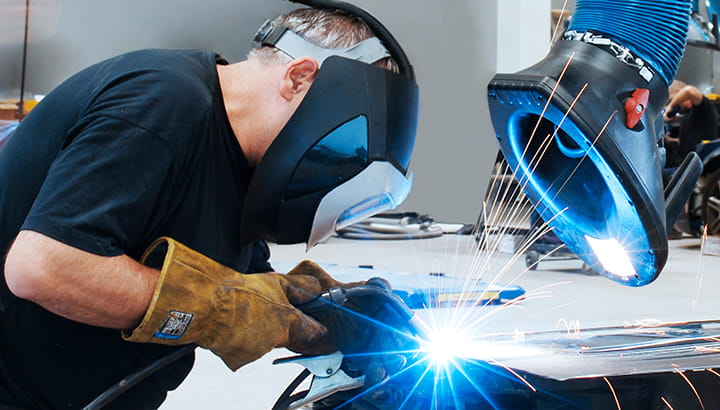
Equipment that captures and filters harmful emissions is often necessary in order to maintain a safe work environment. This consumes energy and for some processes, a significant amount of energy. Whether you operate a small laboratory or a large factory with extraction and filtration systems, there are many ways to reduce energy consumption, especially when the extraction devices do not need to run continuously. In this blog article, I will describe a couple of factors that can reduce the energy consumption of your local exhaust ventilation and filtration systems.
When possible, capturing harmful fumes, smoke and dust at the source of the contamination is the most energy-efficient and effective way of preventing them from reaching the breathing zone or polluting the environment. Also, the extraction point should only be open when needed, with an optimized airflow. Using dampers is a good way to control the airflow. As manual dampers might not be closed, or opened, as often as they could be, automatic dampers controlled by the actual workload can save considerable amounts of energy.
After the contaminated air has been captured at the source, it is transported from the extraction point to a filtering unit. To prevent dust and particles from building up within the ducting, you need to have a sufficient transport velocity, depending on the dust. A workshop might have many extraction points, but sometimes they are not used simultaneously. The sufficient velocity has to be maintained even when the number of used extraction points varies. Still, by dimensioning the duct system in order to achieve a sufficient transport velocity the system will be as energy-efficient as possible.
After being transported through the ducting, the contaminated air reaches the filter unit. As with the duct system, the filter should preferably be dimensioned with regards to how many extraction points that are normally used at the same time. This means that the filter is adapted to an airflow lesser than the sum of the airflows in all of the extraction points combined. For an effective filtering, the transport velocity and airflow should not be unnecessarily high. This way, you keep the pressure drop in the filter at a reasonably low level and thereby save energy and keep the filter in a good condition for a longer time. In addition, it is important to use the proper filter media for the dust type being filtered so the filter cleans easily, minimizing the amount of and frequency of cleaning. The compressed air used for cleaning requires energy and causing wears on the filter. By using a filter that is cleaned automatically with an on-demand compressed air pulse system, you ensure that the filter is performing in an optimal way.
The fan of the dust and fume extraction system is affecting all of the described factors above and this is where you have the biggest potential to save energy and reduce costs. If you let a fan run at full speed at all times regardless of the workload, it will create more airflow than needed which, in turn, wastes energy and wears on the filter. Adjusting fan speed to the actual workload is essential in order to minimize energy consumption and costs.
A Variable Speed Drive (VSD) with pressure control, also called Variable Frequency Drive (VFD) or inverter, will help you control the fan capacity. With the VSD, the pressure in the duct system is controlled and the fan speed is optimized according to the actual amount of airflow needed, up to the maximum capacity. Also, by using fans with backward-curved blades, you get optimal efficiency. Altogether, this will optimize the use of your local exhaust ventilation system, improve filter performance as well as reduce noise levels, extraction of conditioned air and energy costs.
Which adaptations that are right for your local exhaust ventilation system depend on your work processes and the magnitude of these. At Nederman, we have the expertise and product range to provide you with an energy efficient solution that optimizes the use of fans and filters in your production processes. Feel free to contact me with questions!
We have extensive experience of various challenges in the different industries and our experts are very skilled, helpful and professional. With us, you can feel secure that we take care of you and your needs. You are always welcome to contact us regardless if you have a short question or a more complex and complicated one. A warm welcome to Nederman.
Contact us here